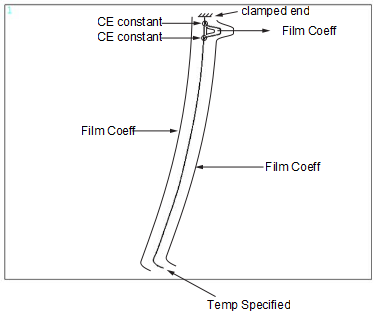For the thermal model, four types of boundary conditions are used (see Figure 29.8: Thermal Boundary Conditions):
TEMP specified at the clamped end
Three different film convection boundary conditions for different regions of the model
Constraint equations to bond the reinforcement to the nozzle body
Constraint equations to enforce cyclic symmetry
A realistic thermal model may have film coefficients that were derived from empirical correlations. Constant values are used here for simplicity. It is possible to specify heat flux boundary conditions instead of convection boundary conditions.
For the structural model, three types of boundary conditions are used (see Figure 29.9: Structural Boundary Conditions):
Displacements specified at the clamped end
Constraint equations to bond the reinforcement to the nozzle body
Symmetry conditions to enforce cyclic symmetry
In addition to the aforementioned boundary conditions, thermal loads are applied to the structural model (LDREAD). This accomplishes loose coupling, as described in the introduction.
For the structural analysis, other mechanical loads could be active that have been ignored (such as pressure and shearing stresses due to gaseous flows). A realistic simulation would account for all possible loads that could be major contributors to stress.



